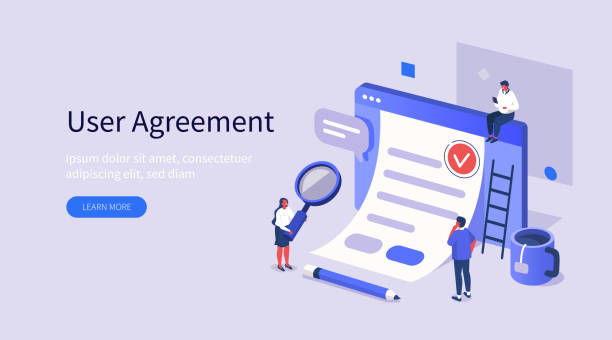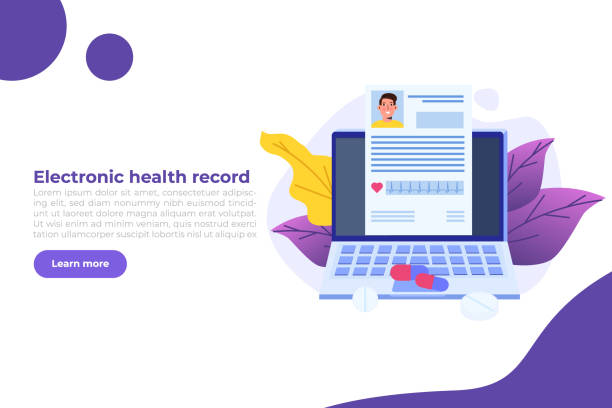Introduction to the Importance of SEO-Optimized Website Design in the Digital Age
In today’s highly competitive world, merely having a website is not enough for an online presence; your website must be visible and easily found by target users.
This is where the concept of #SEO_Optimized_Website_Design emerges as a key strategy.
#SEO, or Search Engine Optimization, is a set of techniques and methods that help improve your website’s ranking in search results.
But why is it so important? Because most users only view the first pages of Google results, and if your website isn’t there, you will practically lose many opportunities.
An optimized website design from the outset is the cornerstone of online marketing success.
This process is not limited to keywords; it also includes technical aspects, site architecture, user experience, and content quality.
The ultimate goal of SEO is to increase organic and targeted traffic to your website, which ultimately leads to increased sales and brand awareness.
In this article, we will discuss in detail the various aspects of SEO-optimized website design and provide practical guidance so that you too can have a successful and #visible website.
The importance of this issue is such that many businesses allocate a significant budget to website optimization.
Are you missing out on business opportunities because of an outdated website? With Rasavab, permanently solve the problem of not attracting potential customers through your website!
✅ Attract more high-quality leads
✅ Increase brand credibility in the eyes of customers
⚡ Get free consultation for corporate website design
Key SEO Principles in Initial Website Design
For a website to be #SEO_friendly from the very beginning, specific principles must be observed during its #initial_design phases.
These technical and content principles ensure that your site gains the #attention_of_search_engines.
One of the most important principles is a proper URL structure; short, descriptive URLs containing keywords help search engines better understand the page’s topic.
Furthermore, using Title Tags and Meta Descriptions that contain relevant and engaging keywords can significantly increase the click-through rate (CTR) from search results pages.
These sections are the first thing users see in Google results and should be designed to be both optimized for search engines and enticing for users to click.
Image optimization using the Alt Text attribute, which provides a brief description of the image, is also highly important, as search engines cannot directly understand visual content.
Additionally, special attention should be paid to the favicon, robots.txt file, and XML sitemap.
These initial steps in SEO-optimized website design are crucial and form the foundation for future successes.
Ignoring these principles can mean costly revisions and corrections in the future, so investing time and resources at the beginning is very logical.
The Role of Keyword Research in SEO-Optimized Website Design and Content Strategy
Keyword #research is the backbone of any #successful_SEO strategy, especially when it comes to SEO-optimized website design.
This process not only helps you identify the keywords users search for to find your services or products but also plays a fundamental role in shaping your website’s architecture, menu structure, and even the type of content you produce.
By accurately identifying target keywords, you can design your website pages so that each responds to one or more specific keywords, which helps search engines understand the relevance of your content to #user_searches.
This is a specialized approach that requires tools such as Google Keyword Planner, Ahrefs, or Semrush.
Engaging and #practical content produced based on accurate keyword research can significantly improve your site’s ranking.
Suppose you have a website selling specific products; keyword research shows you that people search not only for the product name but also for related problems and the solutions your product offers.
This information can help you design landing pages and blog articles to meet these needs.
This process provides practical guidance for content development and ensures you attract targeted traffic.
Ultimately, keyword research is not just an initial step but an ongoing process that needs to be repeated periodically to ensure your website always aligns with changes in #search_algorithms and #user_needs.
| Keyword Type | Description | Application in Website Design |
|---|---|---|
| Short-tail | 1-2 words, high search volume, high competition | For homepages, general categories |
| Long-tail | 3+ words, lower search volume, less competition, more targeted | For product pages, blog articles, FAQ |
| LSI Keywords | Related and synonymous words, help understand the depth of the topic | For enriching content and comprehensive topic coverage |
Optimized Information Architecture and User Experience for SEO
Information Architecture and User Experience (or #UX) are two vital factors that directly impact your website’s SEO.
A #strong_information_architecture means a logical and hierarchical organization of website content that is understandable and navigable for both users and search engine bots.
This includes designing clear navigation menus, using breadcrumbs, and a #well_organized internal linking structure.
The goal is for users to easily move from one page to another and find the information they need, and for search engines, on the other hand, to easily crawl and index all pages of your site.
An excellent user experience indirectly affects SEO; low bounce rate, high time on site, and more pages visited are all positive signals for Google, indicating that your content is valuable and satisfies users.
As a result, Google will be more inclined to rank your website higher.
This topic in the field of SEO-optimized website design is one of the most important indirect factors to consider.
Click here to preview your posts with PRO themes ››
A user-friendly website that is logically organized greatly contributes to improving user experience and ultimately SEO.
For example, category pages should be properly defined, and product pages should be easily accessible.
Using fast navigation and efficient internal search also helps users quickly reach their goal.
This analytical and explanatory approach shows how user interface and information architecture can together lead to the success of a search engine optimized website.
Ignoring these aspects, even with excellent content, can lead to a site with poor SEO and low conversion rates, so careful planning in the initial design phases is very important.
Did you know that 85% of customers check your company’s website before any interaction?
With Rasavab, build a corporate website worthy of your credibility.
✅ Increase customer credibility and trust
✅ Attract high-quality leads
⚡ Get free website design consultation
The Importance of Load Speed and Responsiveness in SEO
Website load speed and its responsiveness (Responsive Design) are two #critical_technical_factors that directly impact #SEO_ranking and #user_experience.
In today’s world, where users have high expectations for speed, every second of page load delay can mean losing visitors.
Google has also clearly stated that site speed is an important ranking factor, especially with the introduction of Core Web Vitals.
A slow website not only provides a poor user experience but can also increase the bounce rate and ultimately lower your ranking in search results.
To improve speed, techniques such as image optimization, code compression (HTML, CSS, JavaScript), browser caching, and utilizing CDN (Content Delivery Network) can be used.
This specialized aspect of SEO-optimized website design is presented as an essential and tangible aspect.
Also, given the significant increase in the use of mobile devices for internet access, #website_responsiveness has become a necessity.
A website that does not display correctly on different screen sizes (mobile, tablet, desktop) not only disappoints mobile users but will also be penalized by Google.
Responsive design ensures that your website works well on any device and provides a consistent user experience.
This has gained double importance, especially with Google’s Mobile-First Indexing approach.
An SEO-optimized website design should be implemented from the very beginning, taking these two fundamental factors into account, to benefit from SEO advantages and user satisfaction.
This analytical approach shows how technical aspects directly impact the overall success of a website.
Producing Quality Content and Its Impact on Site SEO
Content is king; this phrase holds true more than ever in the world of SEO.
Producing #quality, #unique, and #valuable content is one of your most powerful tools for improving #website_SEO.
Search engines look for content that addresses user needs, provides accurate and comprehensive information, and is continuously updated.
Quality content is not limited to text; it can also include images, videos, infographics, and podcasts.
The deeper, more practical, and more engaging your content, the more likely users are to spend more time on your site, share it with others, and link to it, all of which are positive signals for Google.
In fact, good content plays a vital role in the success of an SEO-optimized website design.
This is an educational yet #entertaining approach that shows you how to increase your organic site traffic through creative content production.
For example, creating blog articles that answer common user questions, producing instructional videos related to your products or services, or designing engaging infographics that present complex information in a simple and visual way.
This type of content is not only useful for users but also helps you become recognized as an authority in your field.
For example, if you are active in the field of SEO-optimized website design, you can write articles about “10 Common SEO Mistakes to Avoid” or “How to Transform Your Site’s SEO with Video Content.”
This ensures that both users are attracted to your content and search engines understand the value of your site.
Click here to preview your posts with PRO themes ››
Advanced Technical SEO for Website Design
Beyond the basics, #advanced_technical_SEO includes a set of optimizations that directly impact how your website is crawled, indexed, and understood by search engines.
This aspect of SEO-optimized website design requires more specialized knowledge and can include items such as implementing #Schema_Markup or structured data.
Schema Markup helps search engines better understand your page content and display it in rich formats (Rich Snippets) in search results, which can significantly increase your click-through rate.
For example, if you have an e-commerce site, you can use schema to display product ratings, prices, and availability in search results.
Issues related to Duplicate Content and the use of Canonical tags to prevent penalties from Google are also other aspects of technical SEO.
Furthermore, managing 404 errors, 301 redirects, and optimizing the Crawl Budget for large sites are of high importance.
An SEO-optimized website design must ensure that all these technical aspects are correctly implemented to leverage the website’s maximum potential in search engines.
This section includes #news and #specialized aspects that provide new and in-depth information to developers and SEO specialists.
Staying informed about the latest changes in Google’s algorithms and new tools is also crucial in this field.
| Technical Element | Description | Impact on SEO |
|---|---|---|
| Schema Markup | Adding structured data to HTML | Display Rich Snippets, increase CTR |
| Robots.txt | Control bot access to pages | Optimize crawl budget, prevent indexing of unimportant pages |
| Sitemap XML | Roadmap for search engines | Ensure all important pages are crawled and indexed |
| Canonical Tags | Specifying the original version of a page | Prevent duplicate content issues |
Internal and External Linking Strategies for Improving Site Ranking
Linking, both internal and external, is one of the #most_important_ranking_factors in Google’s algorithms.
#Internal_links help search engines understand your website’s structure and identify the importance of different pages.
Additionally, these links improve user experience, as users can easily access relevant content.
A strong internal linking strategy includes linking from high-authority pages to more important pages on the site, using relevant Anchor Texts, and logically distributing Page Authority across the site.
For example, if you have written a long article about SEO-optimized website design, you can link to different sections of that article or other related articles.
On the other hand, #external_links or Backlinks from other websites to your site play a vital role in increasing your site’s credibility and Domain Authority.
Google interprets backlinks as a vote of confidence in your content.
The greater the number and quality of incoming backlinks, the more credible your site will be in Google’s eyes.
However, quality takes precedence over quantity; one backlink from a reputable and relevant site is worth far more than dozens of backlinks from irrelevant and spammy sites.
External linking strategies include creating linkable content, collaborating with bloggers and influencers, and publishing content on reputable news platforms.
This section is a comprehensive guide to building a healthy and powerful link profile that significantly improves website ranking and is an integral part of professional website SEO.
Tired of losing customers due to poor e-commerce website design? With Rasavab, solve this problem permanently!
✅ Increase sales and conversion rate from visitor to customer
✅ Smooth and engaging user experience for your customers⚡ Get free consultation
Monitoring and Analysis of SEO-Optimized Website Performance
#SEO_optimized_website_design is not a one-time process; rather, it requires continuous monitoring and analysis to ensure that SEO goals are achieved and the website remains in its best state.
Tools like Google Search Console and Google Analytics provide valuable information about your site’s performance in search engines and user behavior.
Google Search Console allows you to monitor crawl errors, indexing issues, keyword performance, backlinks, and site speed.
These tools provide information that is crucial for identifying technical issues and opportunities for SEO improvement.
Google Analytics also provides deeper insights into user behavior on your website, including the number of visitors, visit duration, popular pages, bounce rate, and user paths.
By analyzing this data, you can optimize your content, improve user experience, and adjust your marketing strategies.
For example, if you notice that users leave the site after visiting a specific page, you can improve that page’s content or add internal links to relevant pages.
This analytical approach helps you make data-driven decisions and maximize the return on your investments in SEO-optimized website design.
Regular monitoring and reporting are key to sustained success in SEO.
This #key and #specialized information defines your website’s progress path and empowers you to make decisions based on real data.
Click here to preview your posts with PRO themes ››
Challenges and Future of SEO-Optimized Website Design
The world of #SEO is constantly changing and evolving, bringing challenges for specialists in SEO-optimized website design.
Google’s algorithms are continuously updated and require #continuous_adaptation.
One of the biggest challenges is keeping pace with these changes and ensuring your website continues to operate according to SEO best practices.
Another challenge is intense competition in many industries; many businesses strive to rank for similar keywords, which requires #more_advanced and #creative_strategies.
Furthermore, the increasing importance of voice search and artificial intelligence in search results has created new challenges for content optimization and formatting.
The future of SEO-optimized website design is moving towards a more user-centric experience, semantic search, and more specialized content.
Search engines are increasingly seeking to understand user intent and provide the most accurate and relevant results, even if users use natural language in their searches.
This means that websites must produce deeper and more comprehensive content that responds not only to specific keywords but also to a wide range of user questions and needs.
In the future, the importance of #technical_SEO, #site_speed, and #security (HTTPS) will also increase.
The question that arises is, “Are businesses ready for these changes?” This is a #thought-provoking_content and also #news that examines future trends in website optimization.
Readiness for these changes will be the key to success in the future online world.
Frequently Asked Questions
| Question | Answer |
|---|---|
| What is SEO-optimized website design? | Designing a website that is optimized for both users and search engines to achieve higher rankings. This includes adhering to technical, content, and user experience principles. |
| Why is SEO important in website design? | The importance of SEO in website design is because it increases site visibility in search results, attracts organic traffic, improves user experience, and boosts user credibility and trust. |
| What are the most important elements of SEO-friendly website design? | Responsiveness (mobile-friendliness), high load speed, clear navigation structure, correct use of heading tags (H1-H6), image optimization, and quality content. |
| What is the impact of responsiveness (mobile-friendliness) on SEO? | Google uses mobile-first indexing, meaning it prioritizes the mobile version of websites for ranking. Therefore, responsiveness is crucial for SEO. |
| What is the role of site speed in SEO? | Faster websites provide a better user experience, reduce bounce rate, and are favored by search engines. Site speed is one of Google’s ranking factors. |
| How to optimize images for SEO? | By compressing image sizes, using descriptive and relevant file names, and most importantly, writing appropriate and content- and keyword-related alternative text (Alt Text). |
| What is the importance of content in SEO-centric design? | Quality, relevant, and keyword-rich content is crucial for attracting and engaging users, as well as for ranking in search engines. Content is the king of SEO. |
| How does URL structure affect SEO? | Clean, descriptive, short, and keyword-containing URLs help users and search engines better understand page content and appear in search results. |
| What is Schema Markup and what is its role in SEO? | Schema Markup is structured data that helps search engines better understand site content and display it as Rich Snippets in search results, which increases the click-through rate (CTR). |
| Should SEO be considered from the beginning of website design? | Yes, it is highly recommended. Integrating SEO principles from the initial phase of website design saves time and cost and leads to better and more sustainable results in the long run. |
And other services of Rasavab Advertising Agency in the field of advertising
Smart Content Strategy: Professional optimization for customer behavior analysis using user experience customization.
Smart Customer Journey Map: A specialized service for increasing click-through rates based on marketing automation.
Smart Digital Advertising: Transform campaign management with the help of key page optimization.
Smart Custom Software: A professional solution for customer behavior analysis focusing on custom programming.
Smart UI/UX: A fast and efficient solution for online growth focusing on SEO-driven content strategy.
And over hundreds of other services in the field of internet advertising, advertising consulting, and organizational solutions
Internet Advertising | Advertising Strategy | Advertorial
Sources
SEO-Optimized Website Design: Step-by-Step to Success
SEO Site Principles for Improving Google Ranking
The Importance of SEO in Website Design and Online Business
Golden SEO Tips for Increasing Site Traffic
📍 Ready to transform your business in the digital world? Rasavab Afarin Digital Marketing Agency, with expertise in SEO, content marketing, and corporate website design, is your comprehensive solution for online success. Contact us today for a free consultation.
📍 Tehran, Mirdamad Street, next to Bank Markazi, Southern Kazerun Alley, Ramin Alley, No. 6















